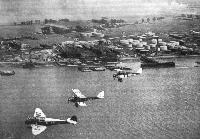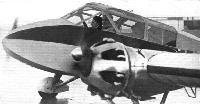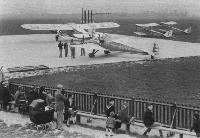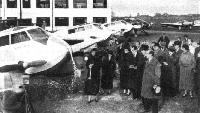
Описание
Страна : Великобритания
Год : 1932
Четырехместный легкий туристический и пассажирский самолет
Варианты
- Gloster, Monospar - ST-3 - 1931 - Великобритания
- General Aircraft - Monospar ST-4 - ST-12 - 1932 - Великобритания
General Aircraft ST-1, ST-2 и Monospar ST-3 - ST-12
<...>
Четырехместный прототип Monospar ST-4 представлял собой традиционный моноплан с неубираемым шасси с хвостовым колесом и силовой установкой из двух звездообразных моторов Pobjoy R мощностью по 85 л. с. За первой партией из пяти Monospar ST-4 последовало примерно 30 самолетов Monospar ST-4 II, минимально отличавшихся от первых пяти. В 1933 году появился прототип конструктивно близкого Monospar ST-6, имевший убираемое шасси. Построен один серийный Monospar ST-6, еще две машины модернизировали до уровня Monospar ST-6 II из варианта Monospar ST-4 II. В начале 1934 года разработан Monospar ST-10 с моторами Pobjoy Niagara мощностью по 90 л. с., с измененной топливной системой и улучшенной аэродинамикой. В 1934 году Monospar ST-10 выиграл гонки на Королевский кубок. Несмотря на удачную конструкцию, за прототипом был построен еще только один Monospar ST-10, далее собрали два очень похожих Monospar ST-11 с моторами de Havilland Gipsy Major, шасси с хвостовым колесом и с убираемыми вручную основными опорами.
Финалом выпуска семейства ранних Monospar стали десять Monospar ST-12, которые отличались от ST-11 только неубираемым шасси.
ТАКТИКО-ТЕХНИЧЕСКИЕ ХАРАКТЕРИСТИКИ
General Aircraft Monospar ST-12
Тип: четырехместный легкий туристический и пассажирский самолет
Силовая установка: два рядных ПД de Havilland Gipsy Major мощностью по 130 л. с. (97 кВт)
Летные характеристики: максимальная скорость на оптимальной высоте 254 км/ч; крейсерская скорость на оптимальной высоте 229 км/ч; начальная скороподъемность 376 м/мин; практический потолок 6400 м; дальность полета 660 км
Масса: пустого 835 кг; максимальная взлетная 1304 кг
Размеры: размах крыла 12,24 м; длина 8,03 м; высота 2,39 м; площадь крыла 20,16 м'
Описание:
- General Aircraft ST-1, ST-2 и Monospar ST-3 - ST-12
- Flight, April 1932
The Stieger ST. 4 - Flight, November 1932
British Aircraft at the Paris Aero Show - Flight, November 1932
British Aircraft - Flight, July 1934
NEW AEROPLANES IN KING'S CUP RACE - Flight, July 1934
MONOSPAR "S.T.10" - Flight, January 1935
A NEW MONOSPAR
Фотографии
-
Flight 1932-11 / Flight
GENERAL AIRCRAFT CO.'S ST4: A similar machine (two Pobjoy engines) will be exhibited at the Paris Aero Show.
-
Flight 1932-10 / Flight
Регистрационный номер: G-ABUZ [6] UNRESTRICTED OUTLOOK: Our photograph emphasises the fact that the pilot of a Monospar never suffers from being unable to see in any direction
-
Flight 1932-08 / Flight
Регистрационный номер: G-ABUZ [6] LONDON-ZURICH-LONDON: The first long flight of the first Stieger S.T.4 Monospar machine after getting its Certificate of Airworthiness was to Zurich during the meeting held there. In Switzerland and Italy the machine aroused a great deal of interest. Flt. Lt. Schofield. who piloted the machine, reports that he had rjo trouble whatever, and the two Pobjoy "R" engines ran faultlessly. Mr. Schofield was kept busy, while at Zurich, demonstrating the S.T.4. It was unfortunate that his visit took place too late for him to take part in the international contests.
-
Flight 1932-06 / Flight
Регистрационный номер: G-ABUZ [6] -
Aeroplane Monthly 1988-04 / J.Stroud - Wings of Peace
Регистрационный номер: G-ABUZ [6] G-ABUZ, the prototype Monospar ST.4.
-
Flight 1932-12 / Flight
Регистрационный номер: G-ABUZ [6] LONDON'S NEWEST AIRPORT: A Monospar and two "Moths" arriving above the recently opened aerodrome and seaplane base at Gravesend.
Другие самолёты на фотографии: De Havilland Gipsy Moth / Moth X - Великобритания - 1928
-
Flight 1932-06 / Flight
Регистрационный номер: G-ABUZ [6] THE ST. 4: The first of the General Aircraft Monospar machines has now been repaired after its recent mishap, when it collided with a fence and damaged a wing tip. The machine has already flown for more than 5 hours and is said to handle very well, while the landing speed is remarkably low.
-
Aeroplane Monthly 1988-04 / J.Stroud - Wings of Peace
Регистрационный номер: G-ABVP [2] G-ABVP Peridot, the third production ST.4, flying just south of Croydon Airport.
-
Flight 1932-10 / Flight
Регистрационный номер: G-ABVP [2] THE START: Capt. Dancy "dropping the flag" for Miss Crossley who flew her "Swift" into third place in the Heston-Cardiff Race. Next to her in the line, Mr. Jackaman's Monospar looked very resplendent.
Другие самолёты на фотографии: Comper Swift / CLA.7 - Великобритания - 1930
-
Aeroplane Monthly 1988-04 / J.Stroud - Wings of Peace
Регистрационный номер: G-ACEW [3] Highland Airways ST.4 Mk II G-ACEW Inverness at the Longman Aerodrome, Inverness, in 1933 before being fitted with the newspaper pannier.
-
Aeroplane Monthly 1983-07 / A.Smith - The friendly Dragons
Регистрационный номер: G-ACEW [3] This Monospar ST.4, G-ACEW, named Inverness was Highland Airways' first aeroplane and remained with the company until 1937.
-
Aeroplane Monthly 1987-06 / L.Curtis - The Flying Duchess (3)
Регистрационный номер: G-ACKT [2] Two views of the ill-fated General Aircraft Monospar ST-4 Mk II G-ACKT, both taken at Croydon in 1933. The ST-4 was powered by two 85 h.p. Pobjoy R radial engines.
-
Flight 1932-08 / Flight
Mr. A. C. M. Jackaman's newly acquired "Monospar." The head-light aperture is clearly visible in the nose of the fuselage.
-
Flight 1933-10 / Flight
SOME BRITISH VISITORS AT BUC: Mr. Graham Mackinnon (right) with his pilot, George Reynolds (left) and Monospar.
-
Flight 1933-08 / Flight Advertisements
The Monospar, designed and manufactured by General Aircraft Ltd. of Croydon, meets the modern demand for an economical twin-engined light four-seater with a good performance, a good view and saloon car comfort for pilot and passenger. All Monospar productions are, of course, Doped with Cellon.
-
Flight 1933-11 / Flight
RISING WITH THE SUN: A "Monospar" (two Pobjoys) flying over the Asahi Aerodrome at Osaka, machine is used by the Asahi Newspaper Co. for service between Japan and Manchuria.
-
Мировая Авиация 139
Регистрационный номер: F-BDAZ Данный Monospar ST-4 был поставлен покупателю из Швейцарии в ноябре 1932 года. Затем самолет перепродавался дважды и в конечном итоге оказался во Франции.
-
Flight 1932-12 / Flight
MONOSPAR CARRIES BOURBON PRINCE: Seated on the right of Capt. R. Stocken in the Monospar, is Prince Sixte de Bourbon-Parme, who, accompanied by Le Comte de Beam (in rear seat) returned to Paris in this machine on December 22, after lecturing before the Royal Geographical Society in London.
-
Flight 1934-07 / Flight
THE THIRTEENTH: Mr. Jackaman's Monospar was No. 13 in the thirteenth King's Cup Race, and he was "eliminated" on July 13th. He is seen here checking the "revs." of his Pobjoy engines.
-
Flight 1934-04 / Flight
MONOSPARS IN BRAZIL: Two Monospar ST.4 machines operated by Viacao Aerea Sao Paulo (VASP) of Brazil.
-
Flight 1939-04 / Flight
Highland Airways - now part of the Scottish Airways system - pioneered the Orkney service. Here is the old Monospar S.T.4 as it was delivered for the Inverness-Kirkwall run in April, 1933; Capt. E. E. Fresson is on the left.
-
Flight 1932-10 / Flight
IN ROME: A cheerful group before the Monospar in Rome. Mr. H. J. Stieger is fourth from the right and Flt. Lt. Schofield third from the left.
-
Aeroplane Monthly 1977-06 / J.Griffin - Portsmouth Airport 1932-1973
Регистрационный номер: G-ABVN A group of onlookers gaze at part of the PSIOW fleet at Portsmouth in 1937. The Westland Wessex G-ARVB was specially built for the airline’s high density routes, and metal tubing replaced the wooden members in the wings. The General Aircraft Monospar ST-4 survived in Australia until 1954, but D.H.60 G-AAAG crashed into the Solent on November 1, 1934, after a low level stall, the two occupants being drowned.
Другие самолёты на фотографии: De Havilland Gipsy Moth / Moth X - Великобритания - 1928Westland Wessex / Westland IV - Великобритания - 1929
-
Aeroplane Monthly 1984-07 / J.Viner - The great Flea race
Регистрационный номер: G-ACGI THE CROWD that came to see the Poux race at Ramsgate on Saturday - and stayed to joy-ride in the airport's Short Scions. Mr. Whitney Straight, incidentally, is having some fine hangars and club buildings erected.
The scene at Ramsgate Airport on August 3, 1936. In the foreground is Ramsgate Airport's Short Scion G-ADDV; behind that is another Scion, G-ACUZ, Monospar ST-6 G-ACGI, a Swallow, Aeronca C-3, a row of Fleas and the Cierva C.30 autogyro.Другие самолёты на фотографии: Aeronca C - США - 1929British Klemm L.25 Swallow - Великобритания - 1933Cierva/Avro C.30A / Rota - Великобритания - 1932Mignet Pou-de-Ciel / HM-14 - Франция - 1932Short Scion / S.16 - Великобритания - 1933
-
Flight 1934-07 / Flight
THE LATEST VERSION: General Aircraft Co.'s S.T.10 has two 90-h.p. Pobjoy "Niagara" engines.
-
Flight 1934-07 / Flight
Types of Machine in the King's Cup Race (5) Monospar "S.T.10," two Pobjoy "Niagara" 90 h.p. engines.
-
Flight 1934-07 / Flight
Регистрационный номер: G-ACTS [5] LANDING, The Monospar "S.T.10" landing at Hatfield. The new, complete cowling of the two Pobjoy engines is neat and clean.
-
Flight 1935-01 / Flight Advertisements
Регистрационный номер: G-ACTS [5] -
Flight 1934-07 / Flight
THE WINNER: Flt. Lt. Schofleld crossing the finishing line in his Monospar "S.T.10" (two Pobjoy 90 h.p. "Niagara" engines) after covering the course of the Final at more than 135 m.p.h.
-
Aeroplane Monthly 1988-04 / J.Stroud - Wings of Peace
Регистрационный номер: G-ACTS [5] The ST.10 G-ACTS which won the 1934 King’s Cup race and later saw service with Portsmouth Southsea & Isle of Wight Aviation.
-
Flight 1935-09 / Flight
IN THE OFFICE: Mr. H. J. Stieger, designer of the "S.T.10," and Managing Director of General Aircraft Ltd., is here standing In the cockpit of the machine before the race started. Seated is Flt. Lt. H. M. Schofield, General Manager and Chief Pilot of the company. He flew the "S.T.10" throughout the race.
-
Flight 1934-07 / Flight
PLEASED: Flt. Lt. H. M. Schofleld carried as passenger throughout the race Mr. H. J. Stieger, the designer of the machine and the inventor of the Monospar system of wing construction.
-
Flight 1938-01 / Flight
Регистрационный номер: G-ACTS [5] The Portsmouth, Southsea and Isle of Wight Aviation Ltd. fleet at Portsmouth in 1937. Four Airspeed Couriers are lined up on the left and a Fox Moth and two Monospars stand behind them. The ST-10 G-ACTS won the 1934 King’s Cup Air Race. It was a prototype and never went into production, but served with PSIOW on the Ryde Ferry.
Другие самолёты на фотографии: Airspeed Courier / AS.5 - Великобритания - 1933De Havilland Fox Moth / D.H.83 - Великобритания - 1932
-
Flight 1933-09 / Flight
"Monospar" (2 Pobjoy) four seater.
-
Flight 1934-09 / Flight
FOR AUSTRALIA: A photograph taken at Croydon of the latest Monospar ST.11, which, as already recorded in Flight, is being delivered to the Australian Government. This machine has large fuel tanks giving a range of 1,100 miles.
-
Aeroplane Monthly 1993-05 / C.Prower - From Brisfit to Beverley (2)
Регистрационный номер: G-ACTS [5] Monospars on the tarmac outside the General Aircraft works at Croydon. G-ACTS was an ST-10, built in 1934 and flown with Portsmouth, Southsea & Isle of Wight Aviation Ltd. The Croydon factory closed down in 1933 and GA moved to better premises at Hanworth the following year.
-
Flight 1934-06 / Flight
POBJOY "NIAGARA" ENGINES FLYING: Mr. C. Gardner has had two of the Pobjoy "Niagara" engines put in his Monospar, and is now carrying out test flights for the makers.
-
Flight 1933-11 / Flight
VIEW OF THE LATEST "MONOSPAR" TYPE S.T., showing the undercarriage retracted and also the new type engine cowling. The re-modelled windscreen should also be noted. These modifications have improved the performance of this machine quite considerably.
-
Flight 1935-09 / Flight
The only entry of its type, the Monospar S.T.12 (two Gipsy Majors), may carry on the tradition of last year's winner. The pilot is O. G. E. Roberts.
-
Air Pictorial 1958-01
Регистрационный номер: VH-UTH Four/five-seater twins of two generations are housed together at Bankstown, Sydney. Monospar ST-12, VH-UTH (c/n. 36), owned by L. G. Taylor, was delivered in 1935, while the Peel River Mining Co.'s Apache, VH-PKA, is of 1957 vintage.
-
Aviation Historian 38 / N.Heap - The Flying Fashionista
Регистрационный номер: VH-UTK [3] Seen here with its racing number “45” for the Brisbane-Adelaide Air Race, General Aircraft Monospar VH-UTK (c/n 38) was borrowed from Airlines of Australia, the manufacturer also being a subsidiary of the British Pacific Trust. The figure in black repairing the nose is almost certainly qualified engineer and pilot May Bradford.
-
Aeroplane Monthly 1979-01 / Personal album
A General Aircraft Monospar ST-12 of unknown origin, in use during the war as a communications aircraft with the Nationalist Air Force. This aircraft may well be the ST-12 ferried to the Ministerio Hacienda, Spain, as EC-W43. It was one of six ST-12s exported about 1935, and was powered by two 130 h.p. de Havilland Gipsy Majors.
-
Air Pictorial 1958-08
Регистрационный номер: G-ACHU -
Aeroplane Monthly 1988-04 / J.Stroud - Wings of Peace
Регистрационный номер: G-ADBN [2] FOR AUSTRALIA: Last week the first pair of a series of Monospar machines ordered by an Australian company where "christened" at Hanworth. This photograph, taken by a Flight photographer, shows the S.T.12, one of the types on order, from an angle which clearly illustrates the characteristic wing-form.
The first ST.12, with Gipsy Majors, G-ADBN. It was at one time used by Air Dispatch and was impressed as BD150. -
Flight 1935-05 / Flight
Регистрационный номер: G-ADBN [2] -
Aeroplane Monthly 1988-08 / A.Henshaw - Miles for the Cup! (2)
Регистрационный номер: G-ADLL A pleasant general impression in Saturday's intermittent sunshine. In the air is the Monospar S.T.12.
Monospar ST-12 G-ADLL, flown by O. G. E. Roberts and numbered 17 for the race, was flown into 19th place at an average speed of 145 m.p.h. -
Flight 1935-09 / Flight
O. G. E. Roberts (right), pilot of the Monospar, checks his course calculations before tne Eliminating Contest.
-
Aviation Historian 38 / N.Heap - The Flying Fashionista
Регистрационный номер: VH-UTK [3] Ivy and Jason pose for a photograph in the cabin of Monospar VH-UTK at the time of the Brisbane-Adelaide Centenary Air Race. It is probable the pair were already romantically involved, but the official line was that Hassard was accompanying Ivy as a navigator and radio operator. Note Ivy’s bespoke khaki flying jacket.
-
Aviation Historian 38 / N.Heap - The Flying Fashionista
Регистрационный номер: VH-UTK [3] Ivy posing with a Monospar, presumably VH-UTK, in 1936. The aircraft was a de Havilland Gipsy Major-powered ST-12; after returning to service on Airlines of Australia’s Brisbane-Townsville route following Ivy and Jason’s participation in the centenary race, it was destroyed by fire on the ground at Mackay on July 1, 1938.
-
Flight 1935-03 / Flight
Mrs. S. M. BRUCE, the wife of the Australian High Commissioner, christens one of the Monospar S.T.12's which are bound for the Commonwealth. In the group may also be seen the Rt. Hon. S. M. Bruce, Mr. and Mrs. Gordon England, Mr. Whitney Straight, Mr. H. J. Steiger (Monospar technical director), and Flt.-Lt. H. M. Schofield.
-
Flight 1935-05 / Flight
The civil side: A number of factories were opened to the public, and this is a scene in the General Aircraft Company's works at Hanworth, with interested visitors examining a Monospar S.T.12 destined for the Heston - Croydon "ferry" service.
-
Aeroplane Monthly 1988-04 / J.Stroud - Wings of Peace
View of a Monospar ST.4 before fabric covering - April 1932.
-
Flight 1932-04 / Flight
SIDE VIEW OF THE ST.4: The single girder of the fuselage primary structure can be clearly seen. Note also swivelling tail wheel. A corresponding view of the scale model is at the top of the page.
-
Flight 1932-04 / Flight
THE BUSINESS PORTION OF THE ST.4: The Pobjoy "R" engines drive Fairey metal airscrews. Note the slimness of the Dowty telescopic legs. The cabin is reached via hinged combined doors and roof.
-
Flight 1932-04 / Flight
THE PORT POBJOY Some wing root details may also be seen.
-
Flight 1932-04 / Flight
ENGINE SUPPORT: The engine plate proper is carried on four tubes forming a "double wedge," and prevented by a continuation of the leading edge from swinging laterally. Note the oil tank and cooler.
-
Flight 1932-04 / Flight
THE POSTERIOR ASPECT: This view, taken from immediately behind, shows wing construction, etc., rather well. Note the placing of the petrol tanks in the wings. The top boom of the wing spar continues right across the fuselage.
-
Flight 1932-04 / Flight
REAR END OF THE FUSELAGE: Details included are the tail-trimming gear and the castoring tail wheel.
-
Flight 1932-04 / Flight
THE FUSELAGE GIRDER: The photograph should be examined in conjunction with the sketches on the next page.
-
Flight 1932-04 / Flight
THE SINGLE SPAR: The photograph shows the general arrangement of the shear members
-
Flight 1933-09 / Flight Advertisements
"THE NIGHT PILOT'S EYES" fitted in the cabin of a "MONOSPAR" (General Aircraft Ltd.)
-
Flight 1935-09 / Flight
A neat ventilator built into one of the cabin windows of the Monospar,
-
Aeroplane Monthly 1987-06 / L.Curtis - The Flying Duchess (3)
Регистрационный номер: G-ACKT [2] The wrecked Monospar ST-4 G-ACKT lying at Thrupp's Farm at Lidlington, Bedfordshire on December 5, 1933. The Duchess of Bedford's personal pilot, Bernard Allen, was killed.
-
Flight 1932-02 / Flight
LESSENING HEAD RESISTANCE. That the new monospar (2 Pobjoys) will be a clean aircraft is here very evident. The cut away wing-root, though by no means a new idea, has not been used of recent years and should, particularly in a twin-engined aircraft of this type, ensure effectiveness of the tail controls at all speeds. Even with the tail on the ground the pilot's view will, in this design, be completely unrestricted.
-
Aeroplane Monthly 1988-04 / J.Stroud - Wings of Peace
Регистрационный номер: G-ACEW [3] KEITH WOODCOCK'S painting shows Highland Airways' Monospar ST.4 Mk II G-ACEW Inverness.
-
Flight 1932-01 / Flight
SAFETY, COMFORT AND EFFICIENCY. Attention to detail design is undoubtedly the secret of successful aircraft. It will be seen that the aircraft being turned out by General Aircraft, Ltd., of Croydon, embody very definite ideas on this subject. Mr. H. J. Stieger is one of the younger generation of designers who are not afraid of incorporating ideas which are radically different from those of accepted practice. The Monospar aircraft appear to be streamlined to the limit, while at the same time providing a perfect view for the pilot, together with immunity from forced landings by virtue of the two Pobjoy engines which are used. The full four-seater fuselage does not appear bulky, yet ample room is provided for the passengers. For commercial work where a large number of passengers is not required this machine should have a wide field of usefulness.
-
Flight 1932-04 / Flight
AS IT WILL APPEAR: A composite photograph of a scale model of the ST.4. The actual cowling over the Pobjoy engines will not be of the totally-enclosing type.
-
Flight 1932-04 / Flight
THE FUSELAGE GIRDER: Sketch shows the details of the girder and the torsion bracing, etc.
-
Flight 1932-04 / Flight
THE PRIMARY STRUCTURE OF THE FUSELAGE: The key diagram gives the locations of the details. The torsion bracing has been omitted.
-
Flight 1932-04 / Flight
ON THE ST.4: The trailing portion of the wing roots hinges up alongside the fuselage to allow of folding the wings. It is in this portion of the wing that the lifting of the trailing edge occurs, the object being to reduce interference drag. A step on the trailing edge facilitates getting into and out of the cabin.
-
Flight 1932-04 / Flight
TAILPLANE AND AILERON: The tailplane is shown in the upper photograph and an aileron in the lower. Details of the various members are shown on the right.
-
Flight 1932-04 / Flight
THE SINGLE SPAR: The sketches illustrate structural details. The small sketch at the bottom shows the rib-supporting brackets.
-
Aeroplane Monthly 1988-04 / J.Stroud - Wings of Peace
THE MONOSPAR PRINCIPLE. - A represents the short bracing members, generally tie-rods arranged pyramidally; B is the tension member which takes drag loads; and C the tension member to take anti-drag loads. D are special ribs which form compression members and to which the apices of the pyramids are attached, and E are the light former ribs.
-
Flight 1934-07 / Flight
A MASS BALANCE: To conform with Air Ministry requirements, ailerons must have a mass balance. This is how it is fitted to the S.T.10.
-
Flight 1934-07 / Flight
S.T.10 FUSELAGE DETAILS: The centre portion of the "S.T.10's" fuselage is built up as a unit of steel tubes. The details show how the girder forming the rear portion is made from drawn sections.
-
Flight 1934-07 / Flight
CONSTRUCTIONAL DETAILS of the Monospar "S.T.10." The lettering shows the parts of the main structure to which the small sketches refer. This new model has only one door to the cabin but the whole top opens up as well, making getting in and out a very simple and easy matter.
-
Flight 1935-02 / Flight
Another British gear which retracts longitudinally is that on the Monospar S.T.11.
-
Flight 1935-01 / Flight
In this view are shown the essential features of the structure which combines the engine mounting and the undercarriage. Both sides are identical. The shock-absorbing rubber blocks are carried in each of the rectangular undercarriage legs.
-
Flight 1935-01 / Flight Advertisements
Why "Chassis-borne"? This phrase is aptly employed to signify a structure similar to that in the motor car, or to the keel of a ship; a strong primary arrangement of braced girders (the Monospar system), surrounded by a light superstructure. The superstructure gives high aerodynamic efficiency and an outstanding propensity for cheap repairs by not necessarily fully skilled or licenced engineers, and provides for easy modification to suit a multitude of purposes; it also protects the primary structure from many of the expensive and serious accidents which frequently occur on the best regulated of aerodromes.
-
Flight 1935-09 / Flight
One of the Gipsy Major high-compression engines of the Monospar S.T.12, the only twin-motored machine in the race.
-
Flight 1932-04 / Flight
General Aircraft ST.4 2 Pobjoy "R" Engines
-
Flight 1934-07 / Flight
Monospar "S.T.10" 2 Pobjoy (90 h.p.) "Niagara" Engines
-
Flight 1935-01 / Flight
Monospar "S.T.12" Two 130 h.p. "Gipsy Major" Engines
- Фотографии
























































































